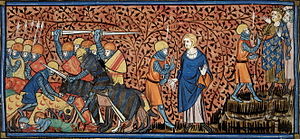Battle of Mortemer

The Norman Duke Wilhelm the Bastard defeats the French in the Battle of Mortemer and sends a messenger to the defeated King Henry I of France. Depiction from Chroniques de Saint-Denis , 14th century
| date | 1054 |
|---|---|
| place | Mortemer near Neufchâtel-en-Bray |
| output | Decisive victory for the Normans |
| Parties to the conflict | |
|---|---|
|
Kingdom of France (French coalition) |
|
| Commander | |
|
Odo (Eudes)
|
|
The Battle of Mortemer took place at the end of 1054 near what is now the municipality of Mortemer between the Normans and the troops of the King of France . In 1057 the Battle of Mortemer was carried over to the Battle of Varaville with the same result.
prehistory
Gottfried II , Count of Anjou had conquered Le Mans , Domfront and Alençon , areas that the Lords of Bellême had received from the king. While King Henry I threatened Gottfried von Anjou directly, Duke William of Normandy (the later conqueror of England ) burned Alençon and besieged the cathedral front, whose garrison surrendered under the promise of free withdrawal.
Wilhelm's marriage to Mathilde von Flanders increased his power so much in the eyes of the king that Heinrich dropped his previous ally and allied himself with Gottfried von Anjou, Theobald I , Count of Blois and Champagne, and rebellious Norman barons.
The campaign
Wilhelm attacked his uncle Guillaume de Talou , besieged his newly built castle in Arques , and took it at the end of 1053. Towards the end of winter 1053/1054, two armies invaded Normandy: from the north, Odo, the king's brother, who crossed the Bresle to reach the Pays de Bray , approached from the south, the king himself and the Count of Anjou who crossed the River Avre and attacked the county of Évreux . The aim was to unite the two armies at Rouen .
Wilhelm took a defensive stance against the threat, but also raised two armies: one under his command, which he led against the king, and one under the command of Gautier Giffards and Roberts of Eu in the Pays de Bray. The two armies were tasked with monitoring the movements of the opposing side and avoiding any direct confrontation until the appropriate moment for action had come.
The battle
The Normans - benefiting from French negligence - attacked the enemy camp during the night, set it on fire and won an easy but devastating victory over the drowsy French.
Result and consequences
Norman acquisitions
In 1057 Heinrich moved through the Orne valley to attack again. This was intercepted at the ford of Varaville near Caen and the marshes of the Dives . From then on, Wilhelm had his hands free to conquer the county of Maine , whose heir he had become after the death of Count Herbert II , who had fled to him. In 1063 Wilhelm captured Le Mans and handed the county over to his young son Robert .
Roger de Mortemer
Roger de Mortemer , lord of Mortemer in the Pays de Bray (today's Seine-Maritime department ), lost his castle in 1054 because he had entrusted Count Rudolf IV of Vexin and Valois , known as Rudolf von Montdidier, who was entrusted to him after the battle released by Mortemer.